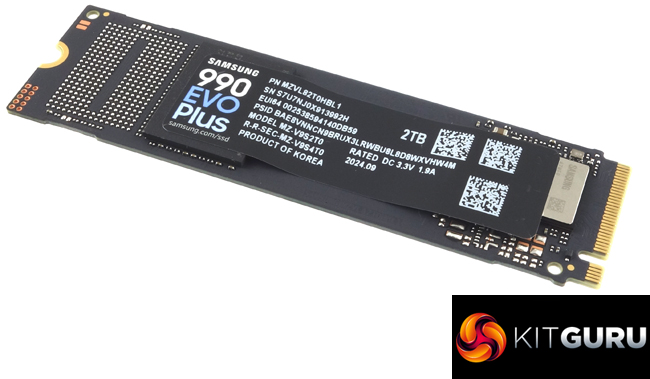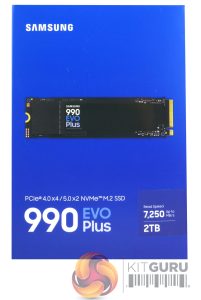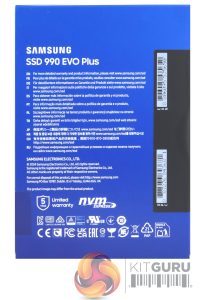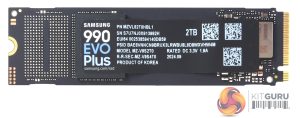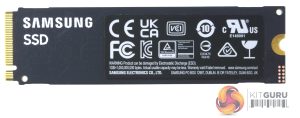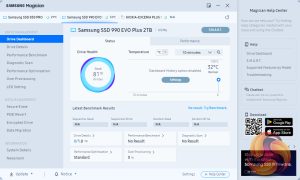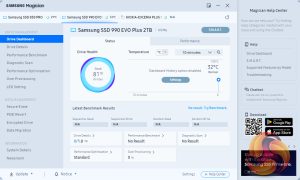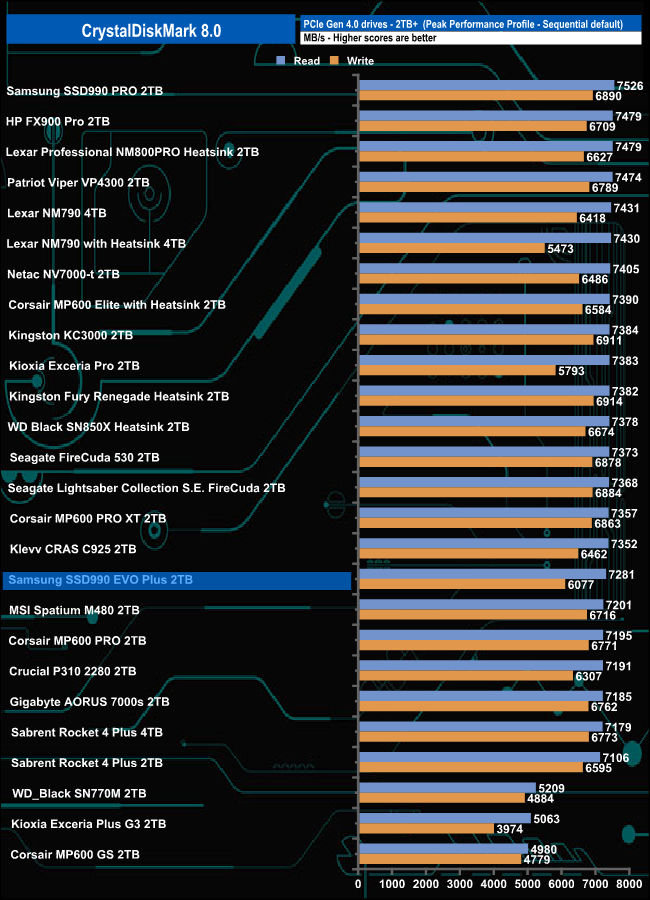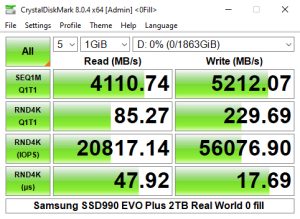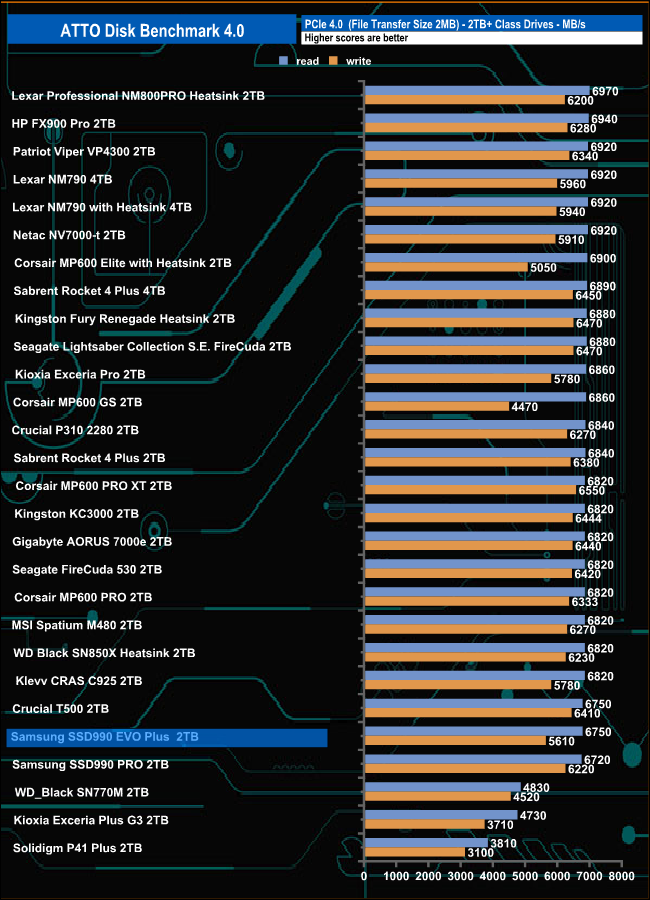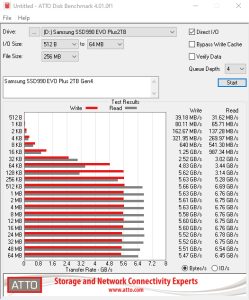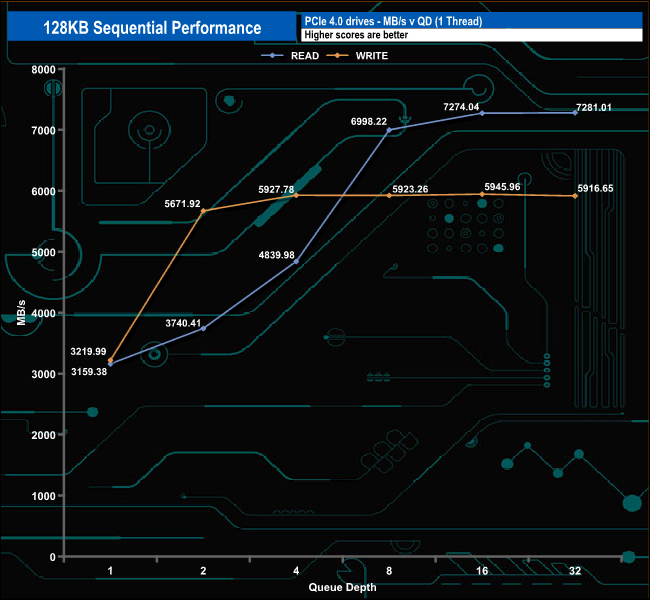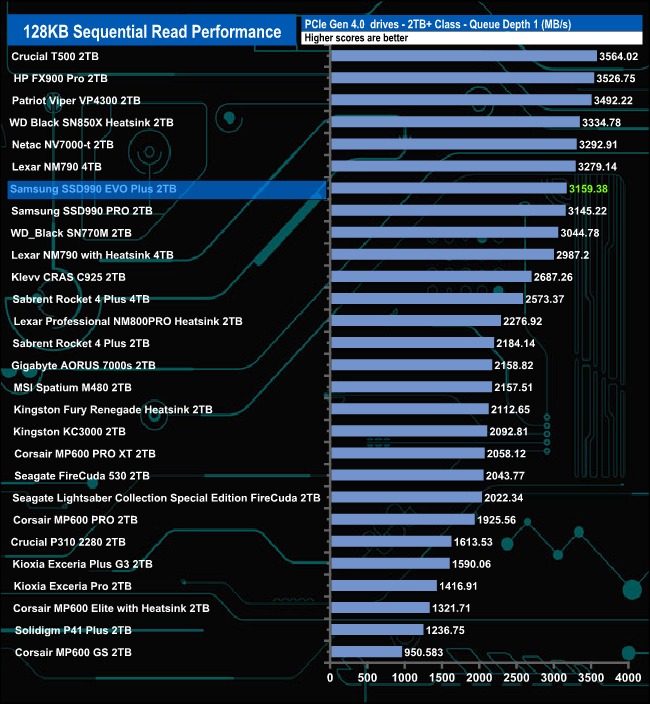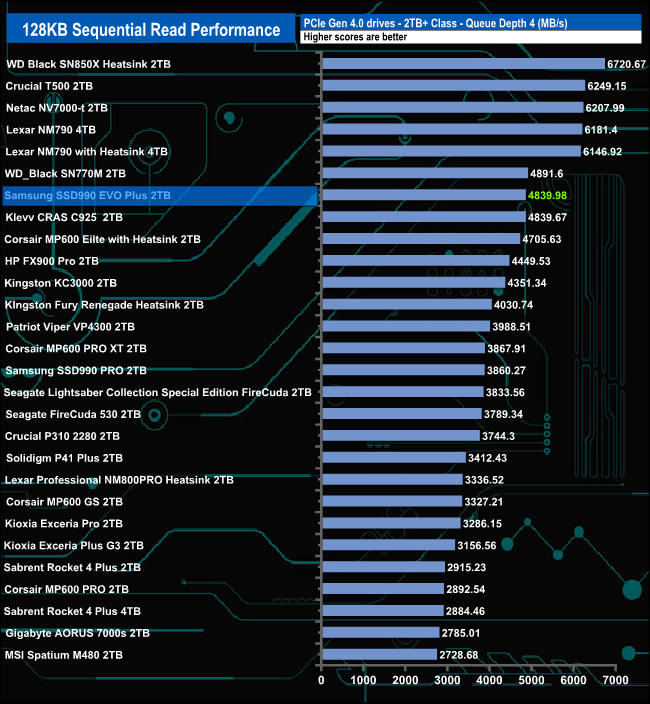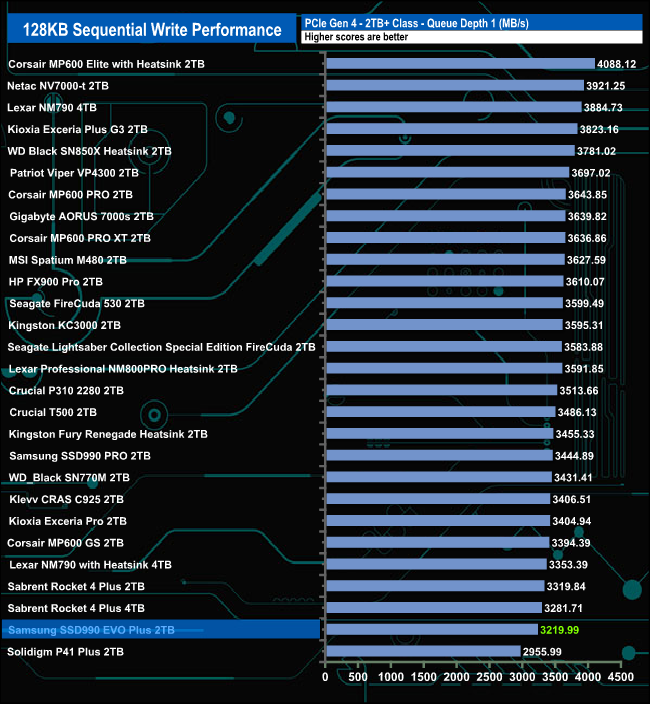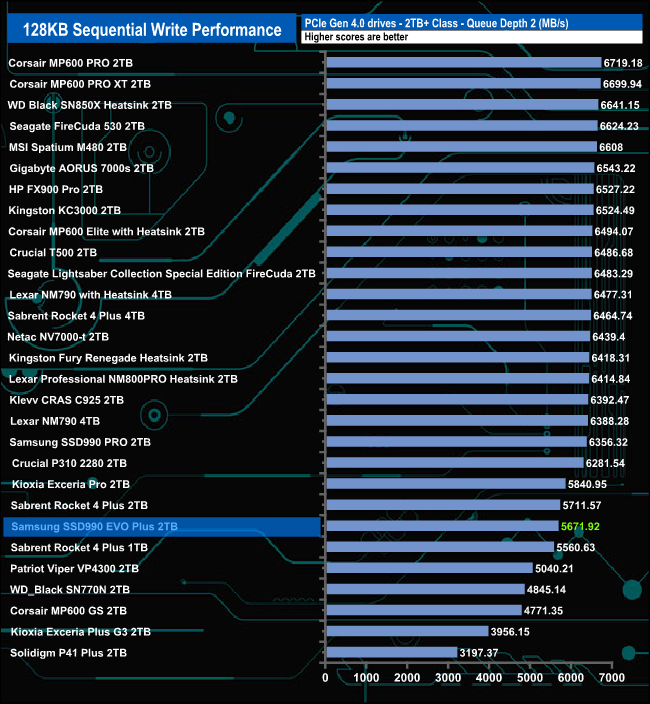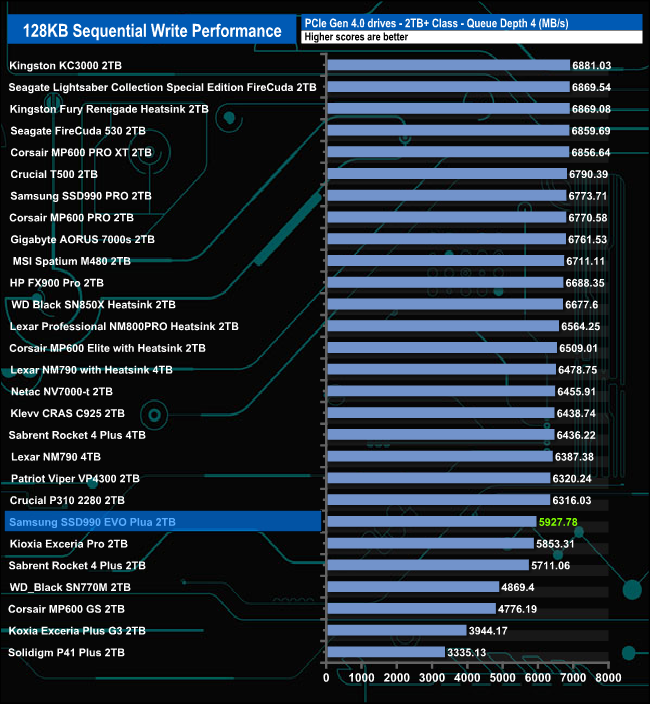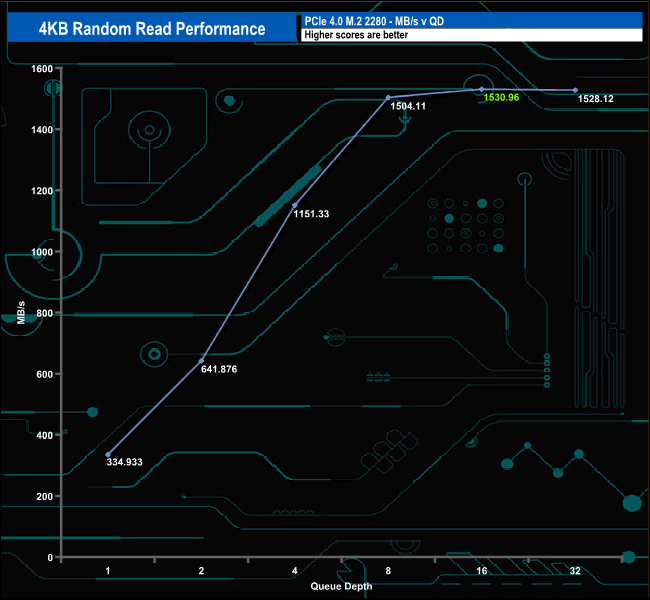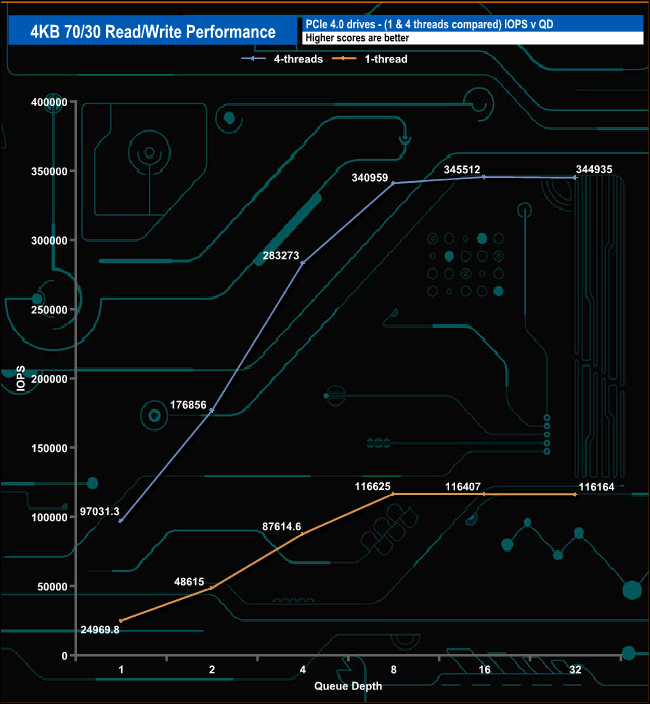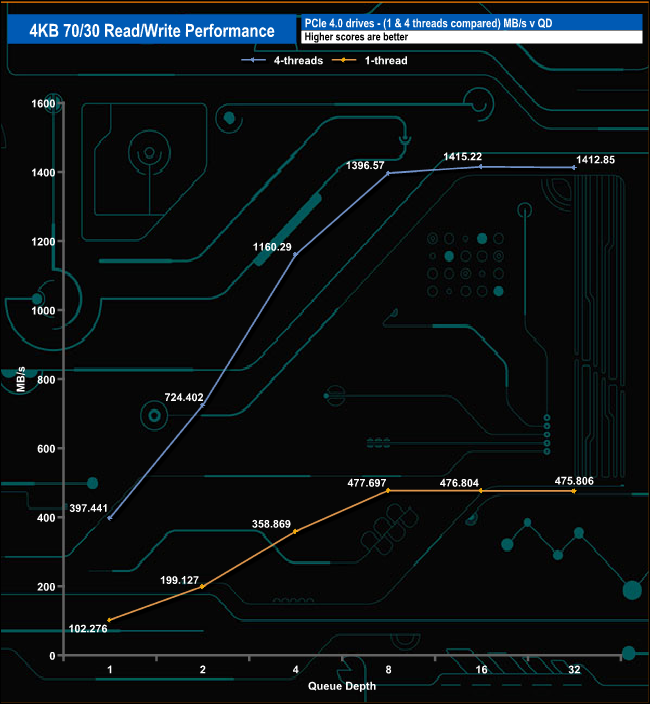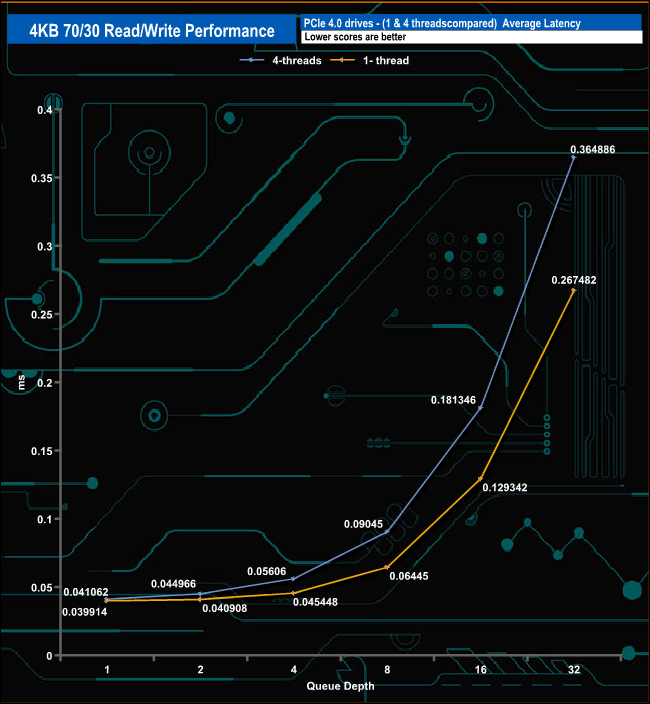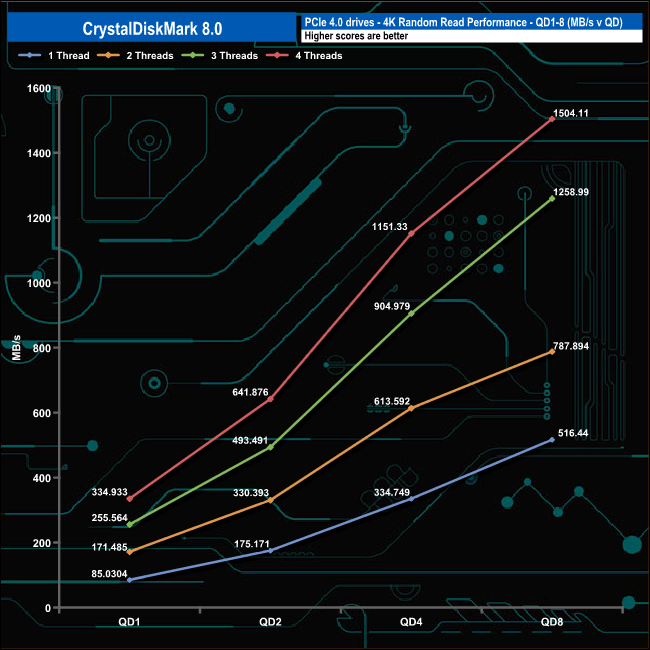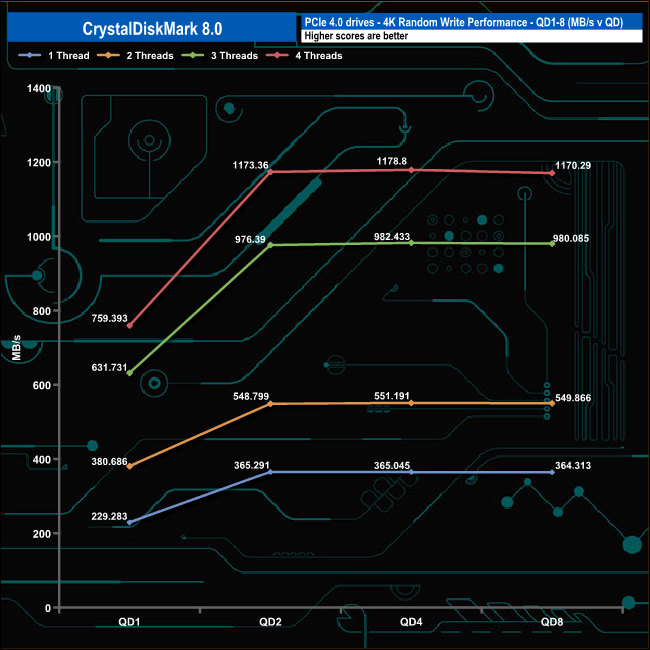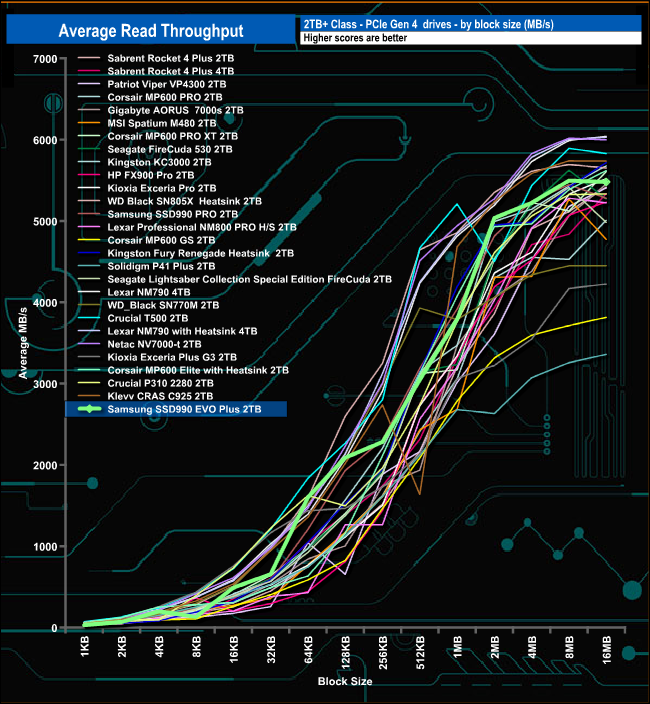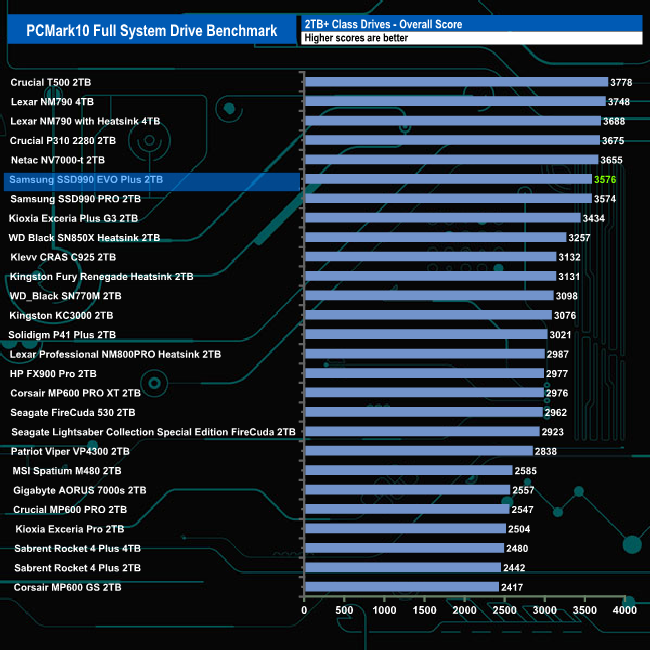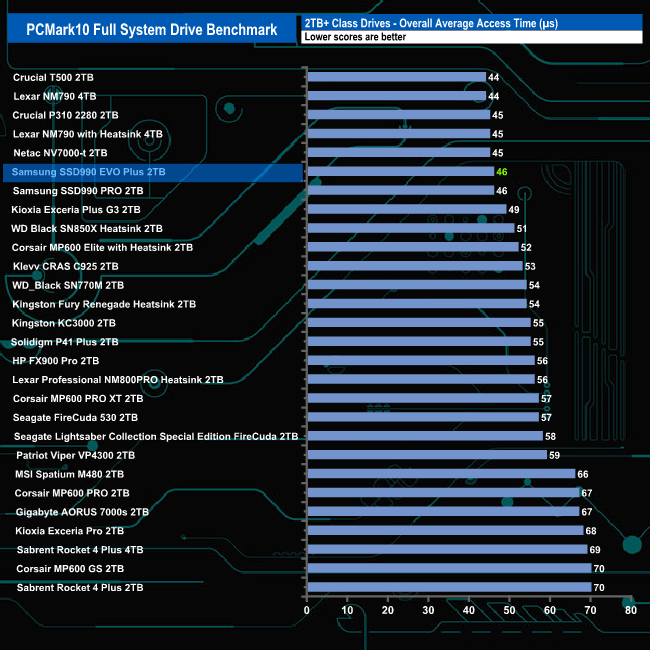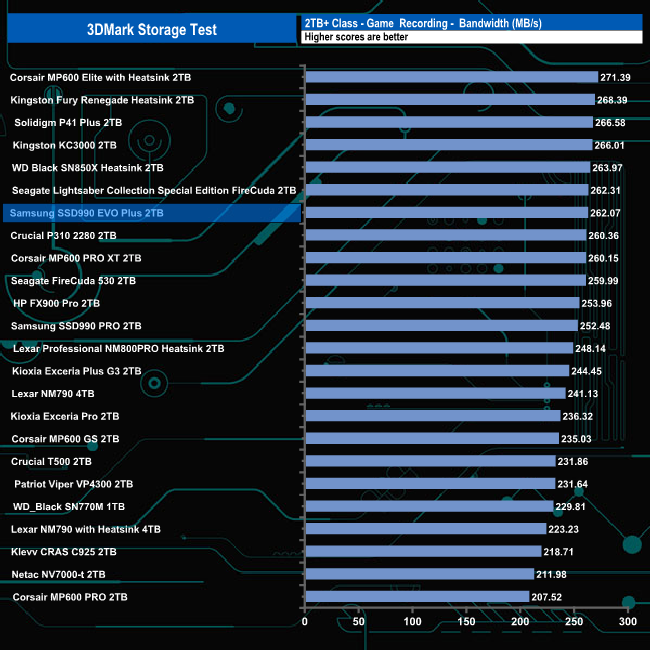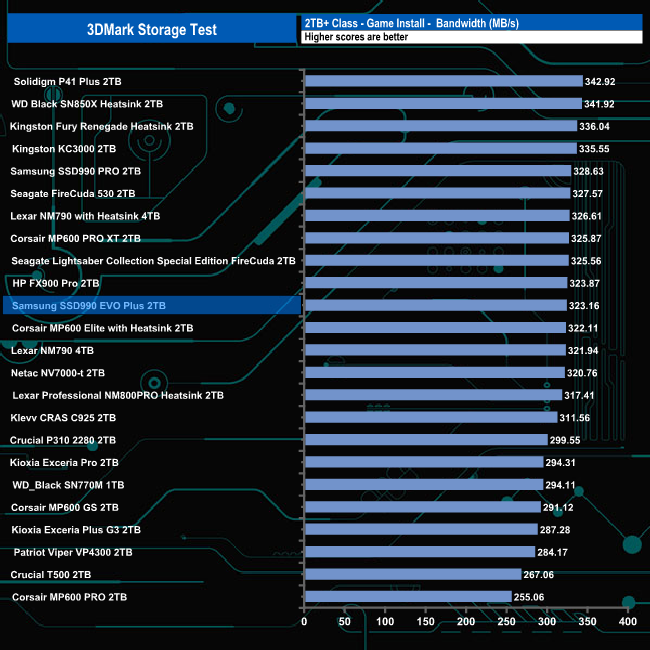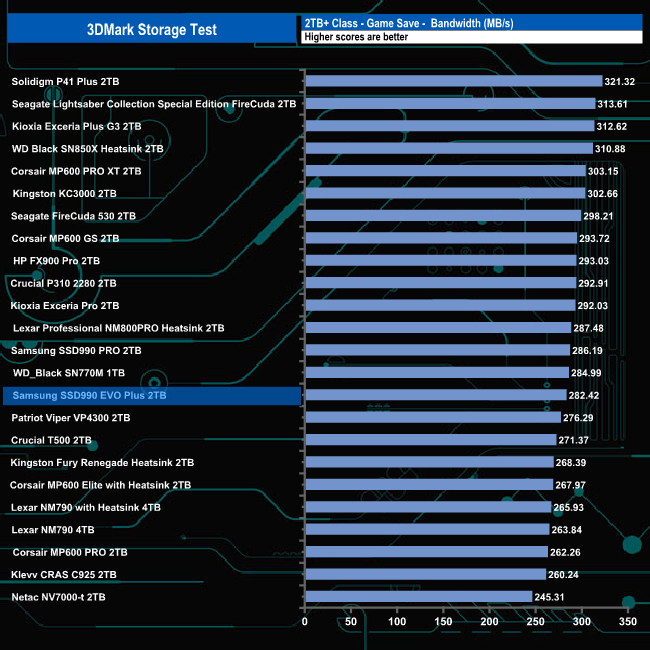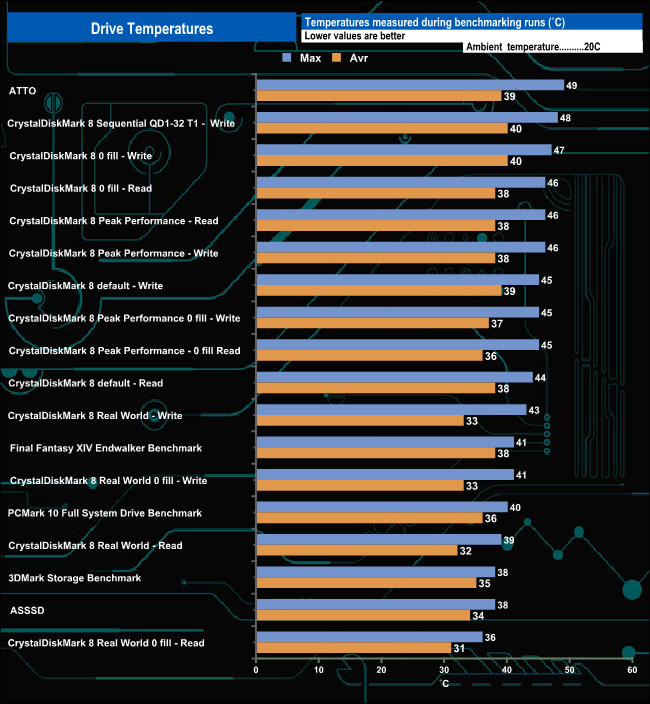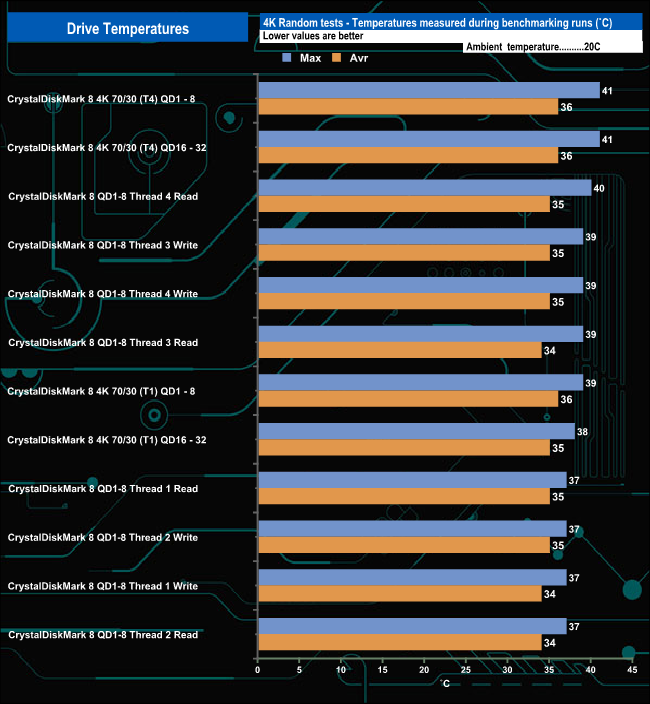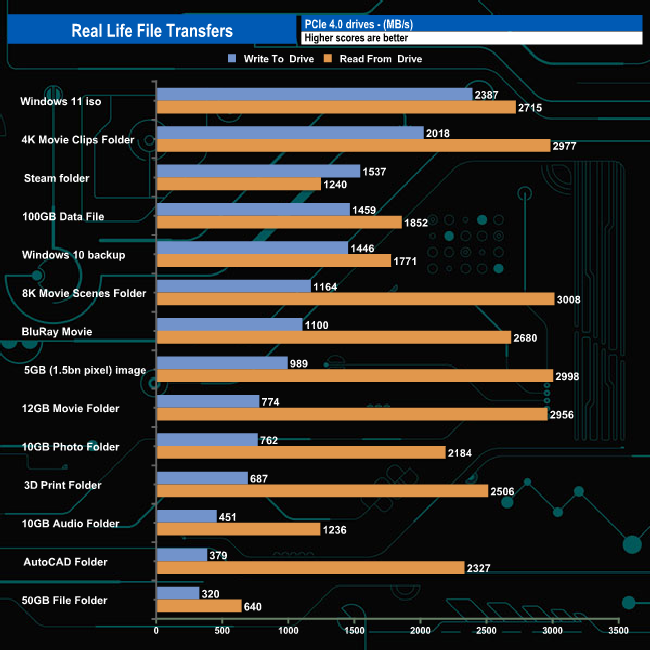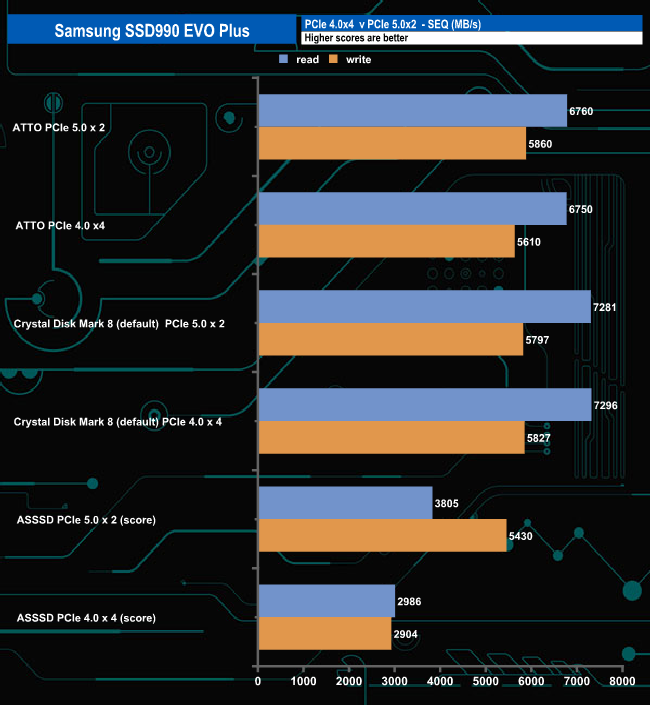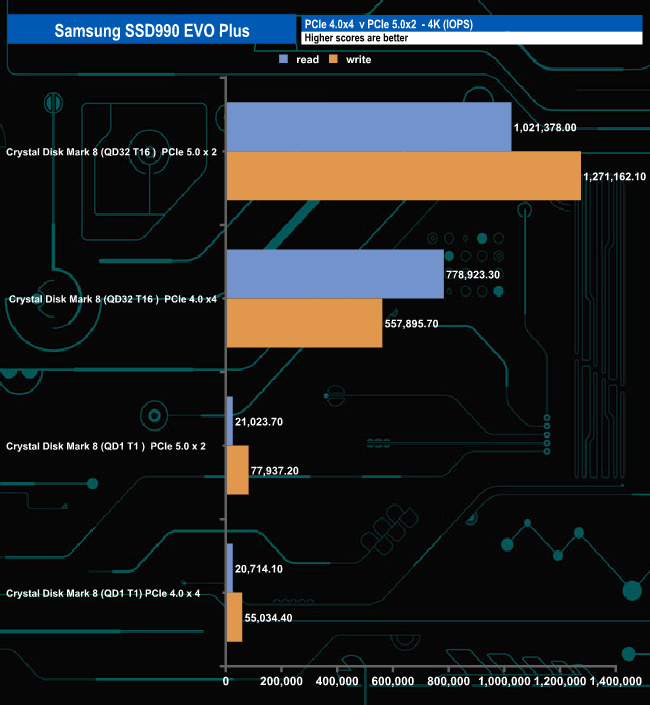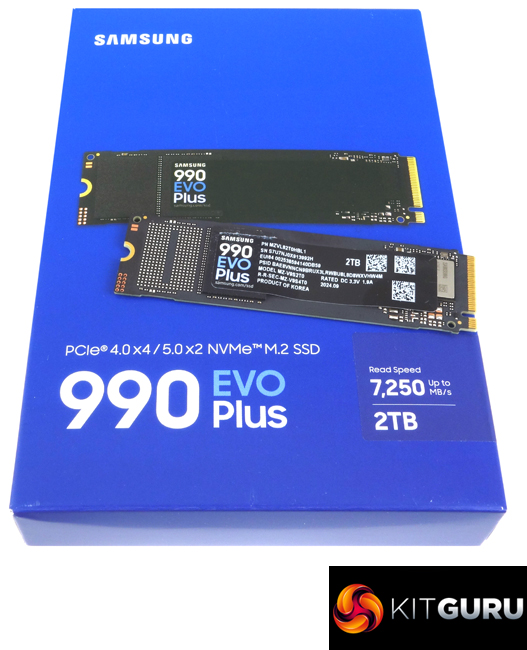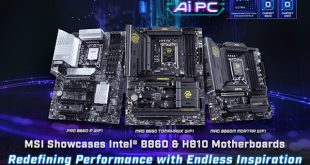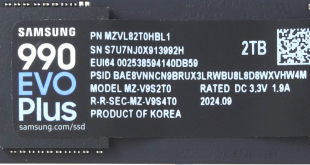
The latest drive to join Samsung's family of SSDs is the SSD990 EVO Plus, a Gen 4 x4 drive with a DRAM-less design that can also run at Gen 5.0 x2 speeds.
At the time of writing this review, the SSD990 EVO Plus drive range consists of three capacities; 1TB, 2TB (the drive we are looking at here) and a flagship 4TB model. At the heart of the SSD990 EVO Plus is an in-house Samsung Piccolo controller which is a four-channel DRAM-less design using HMB (Host Memory Buffer) technology instead of a dedicated DRAM chip. For the EVO Plus the controller looks after Samsung's own eighth generation 236 Layer V-NAND TLC Flash.
Samsung rates the Sequential read performance of the range as up to 7,150MB/s for the 1TB drive while the 2TB and 4TB drives are up to 7,250MB/s. Sequential write performance is the same up to 6,300MB/s for all three models. Random performance is quoted as up to 850,000 IOPS and 1,350,000 IOPS for read and writes respectively for the 1TB drive, 1,000,000 IOPS and 1,350,000 IOPS for the 2TB drive and up to 1,050,00 IOPS for reads and up to 1,400,000 IOPS for writes for the 4TB drive.
Power consumption for the 2TB model is quoted as 4.6W and 4.2W for average active reads and writes respectively. The TBW endurance figure for the 2TB drive is 1,200TB and Samsung backs the drive with a 5-year warranty.
Physical Specifications:
Usable Capacities: 2TB.
NAND Components: Samsung 236 Layer V-NAND.
NAND Controller: Samsung Piccolo.
Cache: N/A, HMB technology.
Interface: PCIe Gen 4 x4 / Gen 5 x2, NVMe 2.0.
Form Factor: M.2 2280.
Dimensions: 80.15 x 22.15 x 2.38mm.
Drive Weight: 9g.
Firmware Version: 1B2QKXG7.
Samsung’s 990 EVO Plus comes in a compact box with a clear image of the drive on the front. On the bottom right-hand side of the box, we find a sticker displaying the drive’s 2TB capacity. Also displayed is the drive's 7,250MB/s Sequential read speed.
The rear of the box has a multilingual information panel giving the web address for more detailed warranty information. Under this is a reminder that the drive has a 5-year limited warranty.
Samsung's 2TB SSD990 EVO Plus is built on a single-sided M.2 2280 format. The product sticker on the rear of the drive has a built-in copper layer to help get rid of some of the heat generated by the drive when working as does the nickel coating on the controller both working in conjunction with Samsung’s DTG (Dynamic Thermal Guard) algorithm.
Under the long Product label on the front of the drive sits Samsung's Piccolo controller and a single package of Samsung's 8th generation 236-Layer TLC NAND (V-NAND). Details about the Piccolo controller are rather scarce but what we do know is that it is a 4-channel DRAM-less design built on a 5nm process.
Samsung’s SSD management utility goes by the name of Magician and can be downloaded from Samsung’s website. Samsung continually updates Magician and the latest version (at the time of writing) is v8.2, Magician is a pretty comprehensive utility that allows you to do most of the maintenance jobs you may need to do with an SSD and lists them under two headings; Drive Management and Data Management.
Drive Management Provides drive information, a performance benchmark, diagnostic scans, performance optimisation and Over Provisioning.
Data Management Provides tools for secure erase, PSID revert, data encryption (the drive supports AES 256-bit full-disk encryption, TCG/Opal V2.0, and Encrypted Drive -IEEE1667 (MS eDrive ) and data migration.
For testing, the drives are all wiped and reset to factory settings by HDDerase V4. We try to use free or easily available programs and some real-world testing so you can compare our findings against your own system. This is a good way to measure potential upgrade benefits.
Main system:
AMD Ryzen 5 3600X, 16GB DDR4-2400, Sapphire R9 390 Nitro and a Gigabyte B550 Aorus Master motherboard. We also tested the Gen 5 x2 performance of the SSD990 EVO Plus using our Gen 5 test rig :- AMD Ryzen 7 7700X, 32GB DDR5-6000, Nvidia GeForce RTX 3050 and a Gigabyte AORUS X670E Xtreme motherboard.
Other drives
Corsair MP600 GS 2TB
Corsair MP600 PRO 2TB
Corsair MP600 PRO XT 2TB
Corsair MP600 Elite Heatsink 2TB
Crucial P310 2280 2TB
Crucial T500 2TB
Gigabyte AORUS 7000e 2TB
HP FX900 Pro 2TB
Kingston Fury Renegade Heatsink 2TB
Kingston KC3000 2TB
Kioxia Exceria Plus 2TB
Kioxia Exceria Plus G3 2TB
Kioxia Exceria Pro 2TB
Lexar NM790 4TB
Lexar NM790 with Heatsink 4TB
Lexar Professional NM800PRO Heatsink 2TB
MSI Spatium M480 2TB
Netac NV7000-t 2TB
Patriot Viper VP4300 2TB
Sabrent Rocket 4 Plus 2TB
Sabrent Rocket 4 Plus 4TB
Samsung SSD990 PRO 2TB
Solidigm P41 Plus 2TB
Seagate Lightsaber Collection Special Edition FireCuda 2TB
Seagate FireCuda 530 2TB
WD Black SN850X Heatsink 2TB
WD_Black SN770M 2TB
Software:
Atto Disk Benchmark 4.
CrystalMark 8.0.0.
AS SSD 2.0.
IOMeter.
UL Solutions PC Mark 10.
UL Solutions 3DMark Storage Benchmark.
Final Fantasy XIV Endwalker Official Benchmark.
All our results were achieved by running each test five times with every configuration this ensures that any glitches are removed from the results. Trim is confirmed as running by typing fsutil behaviour query disabledeletenotify into the command line. A response of disabledeletenotify =0 confirms TRIM is active.
CrystalDiskMark is a useful benchmark to measure the theoretical performance levels of hard drives and SSDs. We are using v8.0.
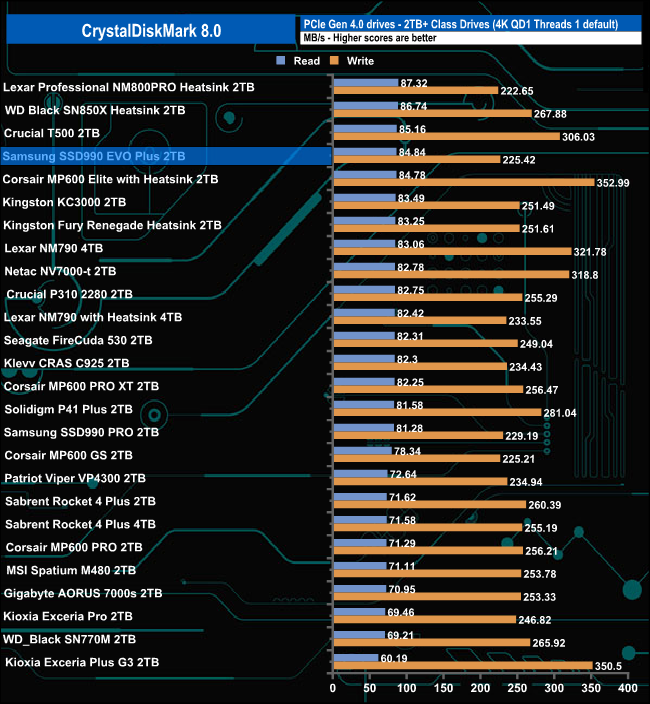
In the CrystalDiskMark 4K QD1 test, the SSD990 EVO Plus has a slightly faster read result than the SSD990 Pro but the older drive has a slightly better write performance.
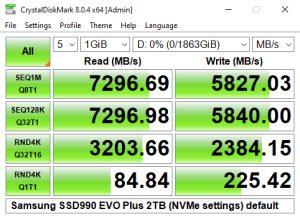
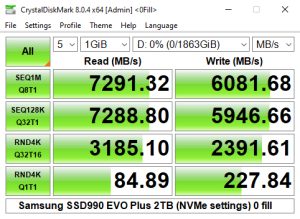
With the CrystalDiskMark 8 default test, we could confirm the official Sequential performance figure of 7,250MB/s with a test result of 7,296MB/s but came up short of the official 6,300MB/s maximum write figure at 5,827MB/s. Using compressed data the write performance increased to 6,081MB/s, still shy of the official maximum.

Those Sequential figures of 7,296MB/s (reads) and 5827MB/s (writes) see the drive in a mid-table position.
Peak Performance profile
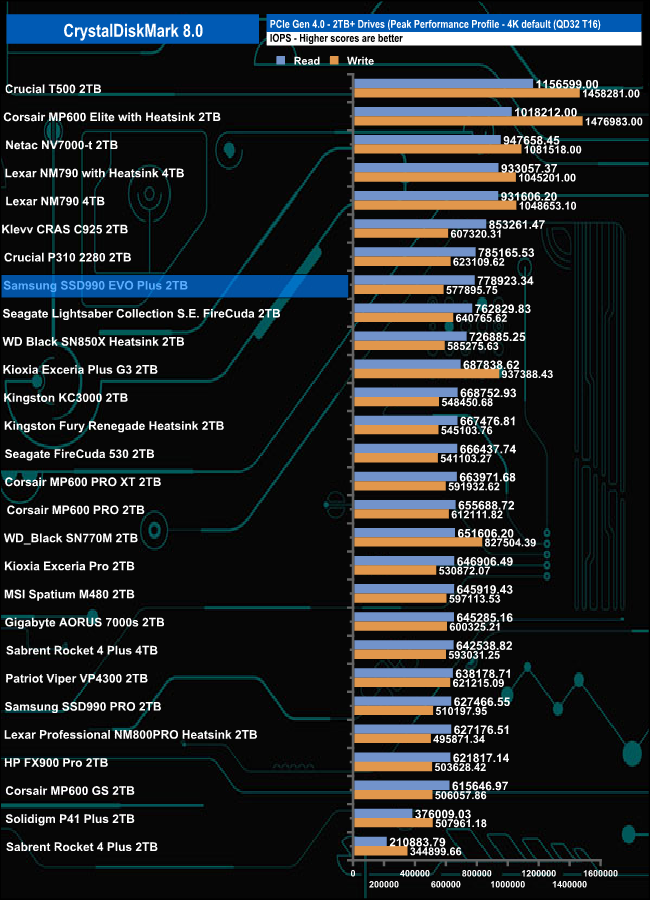
When it came to tested 4K performance our results scores came nowhere close to the official maximums. Samsung rates the 2TB 990 EVO Plus at up to 1,000,000 IOPS for reads and up to 1,350,000 IOPS for writes. The best we saw using the default Peak Performance Profile was 778,923 IOPS for reads and 577,895 IOPS for writes, figures that just get the drive into the top 10 of our result chart.
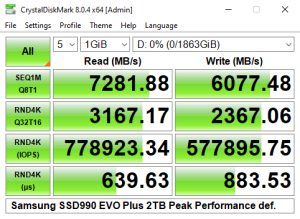

Using CrystalDiskMark 8's Peak Performance Profile we could, once again confirm the official Sequential read figure with a test result of 7,281 while write performance was way short of the maximum 6,300MB/s at 6,077MB/s.
Real World profile
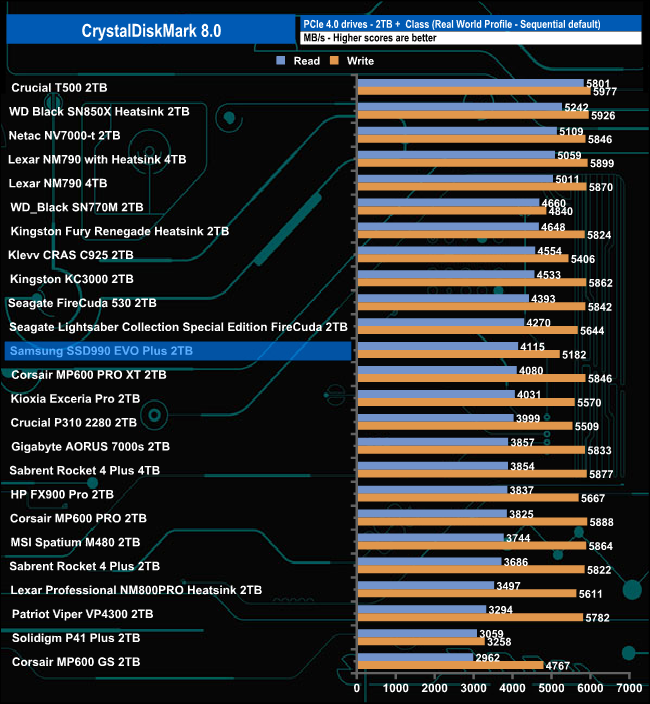
Using the Real World Profile benchmark, the drive landed in a mid-table spot with a read result of 4,115MB/s with writes producing a much stronger 5,182MB/s.
The ATTO Disk Benchmark performance measurement tool is compatible with Microsoft Windows. Measure your storage system performance with various transfer sizes and test lengths for reads and writes. Several options are available to customize your performance measurement including queue depth, overlapped I/O and even a comparison mode with the option to run continuously. Use ATTO Disk Benchmark to test any manufacturer's RAID controllers, storage controllers, host adapters, hard drives and SSD drives and notice that ATTO products will consistently provide the highest level of performance to your storage.
We are using version 4.1 for our NVMe disk tests.
Using the ATTO benchmark we fell short of the official maximum Sequential read/write scores of up to 7,250MB/s and up to 6,300MB/s respectively for the drive with test figures of 6,750MB/s for reads and 5,610MB/s for writes.
AS SSD is a great free tool designed just for benching Solid State Drives. It performs an array of sequential read-and-write tests, as well as random read and write tests with sequential access times over a portion of the drive. It uses incompressible data samples which many drives struggle with, so results can be viewed as the worst-case scenarios.
AS SSD includes a sub suite of benchmarks with various file pattern algorithms but this is difficult in trying to judge accurate performance figures.
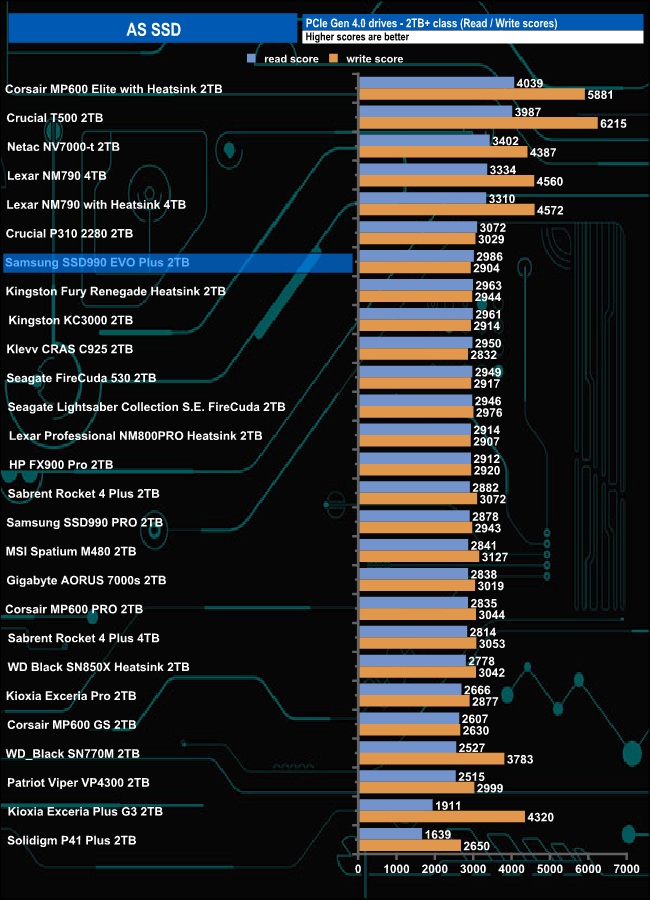
In the AS-SSD benchmark test, the 990 EVO Plus read score of 2986 is 108 points better than Samsung's 990 PRO but the PRO has a slighter better write result.
We used CrystalDiskMark 8‘s custom settings to test the Sequential read and write performance of the drive through a range of queue depths. The setup for the tests is listed below.
128KB Sequential Read / Write.
Transfer Request Size: 128KB, Thread(s): 1, Outstanding I/O: 1-32.

In these Sequential tests could confirm the official read rating of up to 7,250MB/s with a result of 7,281MB/s however the write result wasn't as strong at 5,916MB/s, some 384MB/s short of the official maximum write figure.
128KB Sequential Read compared.
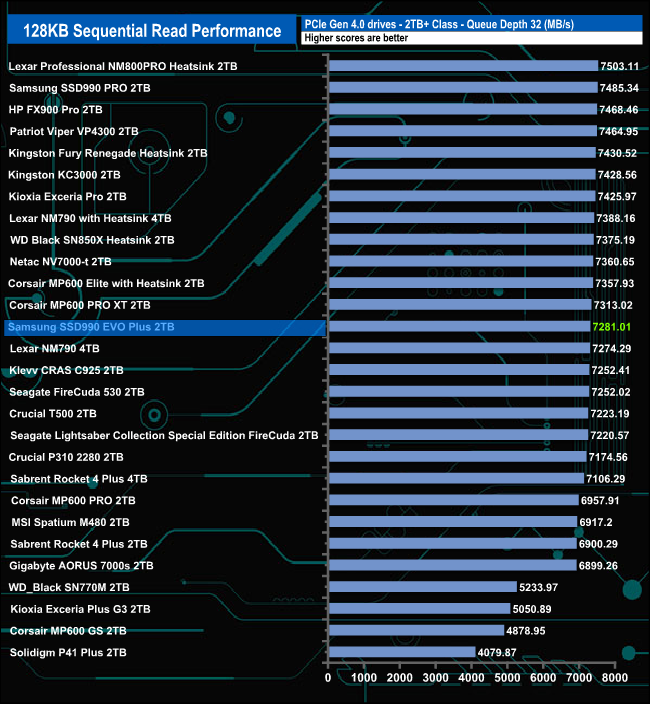
At QD1 the drive sits in seventh place in the Sequential read chart just above the Samsung SSD990 PRO. At QD2 it has slipped down the chart before staging a recovery at QD4. By the end of the test run at QD32, it has slipped out of the top 10.
128KB Sequential Write compared.
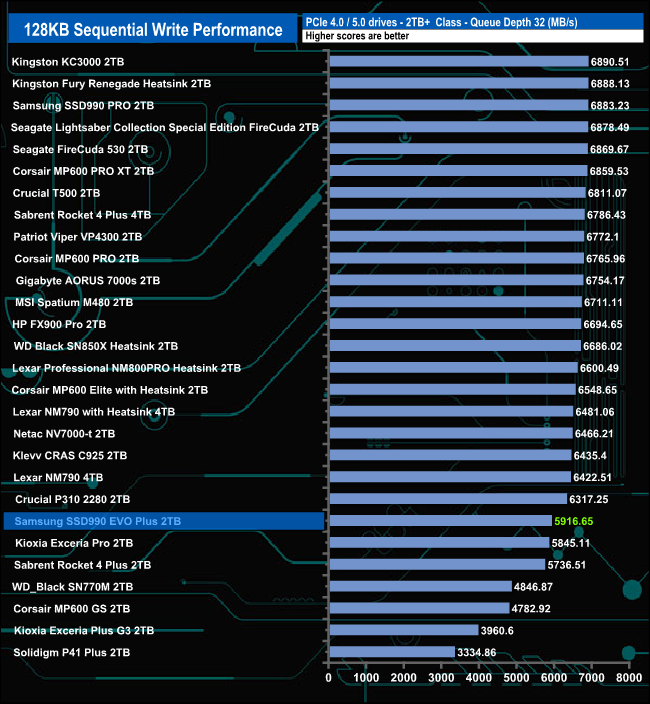
When it comes to Sequential write performance, the drive doesn't do as well, sitting in the penultimate place in the table at QD1. It doesn't really improve much as the QD deepens.
We used CrystalDiskMark 8‘s custom settings to test the 4K random read performance of the drive through a range of queue depths. The setup for the tests is listed below.
Transfer Request Size: 4KB, Outstanding I/O: 1-32.

Using our 4-threaded random read 4K tests we couldn't get close to the official maximum of 1,000,000 IOPS. The drive peaked with a figure of 373,769 IOPS at QD16 before slipping back a little to finish the test run at 373,077 IOPS (QD32).
4K Random Read v QD compared.

Even though our 4K random read test results were nowhere close to the official maximum figure at any stage, the drive sits in the top 10 of Gen4 drives we've tested to date at QD's 1,2 and 4. However by the end of the test run at QD32 its to be found in the bottom section of the table.
We used CrystalDiskMark 8‘s custom settings to test the 4K random write performance of the drive through a range of queue depths. The setup for the tests is listed below.
Transfer Request Size: 4KB, Outstanding I/O: 1-32

The best result we saw from our 4K random write results was 294,019 IOPS at QD16 before the performance dropped back at QD32 at 293.838 IOPS, both of these figures are nowhere near the official maximum of 1,350,000 IOPS.
4K Random Write v QD compared.

The best performance from the drive came at QD2 where it sits just inside the top 10. For the remaining tested queue depths the drive sits in the bottom half of the results chart.
We used CrystalDiskMark 8’s custom settings to test the 4K 70/30 mixed read/write performance of the drive through a range of queue depths using a single thread and four threads.
Samsung's SSD990 EVO Plus had no problem dealing with our 70/30 read/write tests in either single thread or four thread modes however, in both the performance starts to plateau out, using a single thread this happens around QD8 while with four threads it occurs around QD16.
Using a single thread the drive accelerates from 24,968 IOPS (102.27MB/s) at QD1 up to 116,525 IOPS (477.69MB/s) at QD8. From this point, the performance stays more or less at the same level until the end of the test at QD32 with a test figure of 116,164 IOPs (475.80MB/s)
With four threads the drive goes from 97,031 IOPS (397.44MB/s) at QD1 up to 345,512 IOPS (1,415.22MB/s) at QD16 where it levels off, finishing the test run at 344,935 IOPS (1,412.85MB/s).
We used CrystalDiskMark 8 to test the random performance of the drive at lower queue depths (QD1 – QD8 where most of the everyday workloads occur) using 1 to 4 threads.
Random Reads.
In the QD1-QD8 random read tests the drive produced fairly smooth increases in performance as the queue depth deepened without any noticeable dramas. At QD1 the drive speed ranges from 20,759 IOPS (85.03MB/s) using a single thread up to 81,770 IOPS (334.93MB/s) using four threads. At a QD of 8, the single-thread performance had increased to 126,084 IOPS (516.44MB/s) while the four-threaded test reached 367,213 IOPS (1,504MB/s).
Random Writes.

In the 4K write tests, the performance rose quickly from QD1 to QD2 for all four tested threads with the fastest rise seen in the three and four-threaded tests. All four threads see the performance start plateauing out from QD2 onwards up to the end of the test run at QD8.
In our read-throughput test, the drive peaked at the 8MB block size at 5,495.64MB/s, quite some way short of the official maximum of 7,250MB/s.
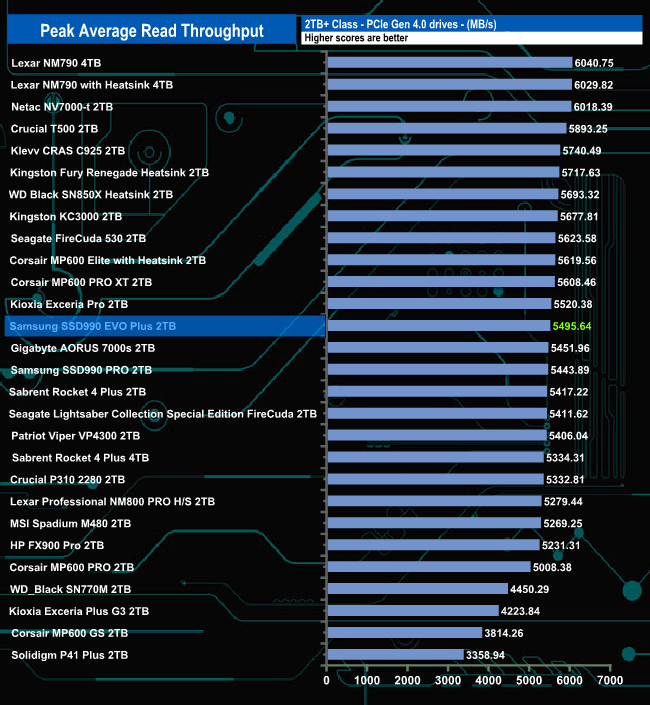
The 990 EVO Plus read figure 0f 5,495.64MB/s is a little faster than the 990 PRO we tested a while ago.
In the write throughput test, the drive peaked at the end of the test with a result of 5,855MB/s, 445MB/s slower than the official maximum of 6,300MB/s.
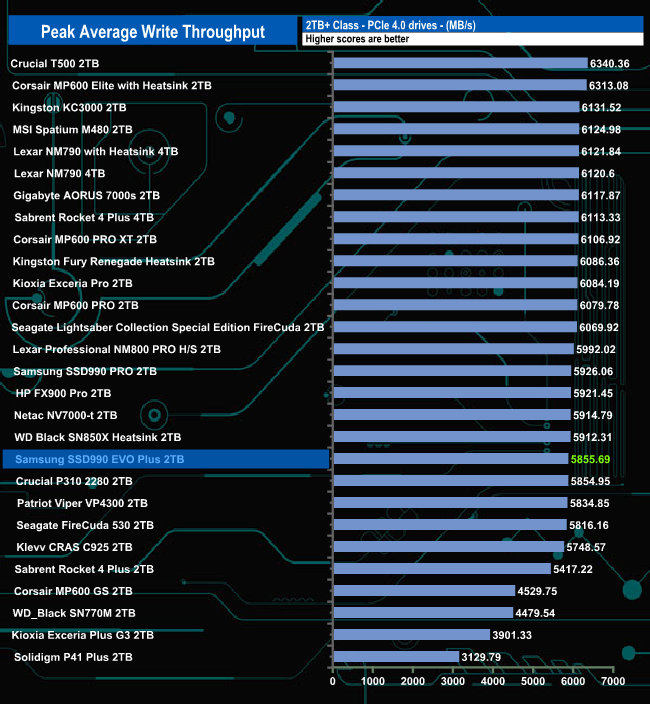
That write test result of 5,855MB/s sees the drive in the bottom half of the results chart.
The PCMark 10 Full System Drive Benchmark uses a wide-ranging set of real-world traces from popular applications and common tasks to fully test the performance of the fastest modern drives. The benchmark is designed to measure performance of fast system drives using the SATA bus at the low end and devices connected via PCI Express at the high end.
The goal of the benchmark is to show meaningful real-world performance differences between fast storage technologies such as SATA, NVMe, and Intel’s Optane. The Full System Drive Benchmark uses 23 traces, running 3 passes with each trace. It typically takes an hour to run.
Traces used:
Booting Windows 10.
Adobe Acrobat – starting the application until usable.
Adobe Illustrator – starting the application until usable Adobe Premiere Pro – starting the application until usable.
Adobe Photoshop – starting the application until usable.
Battlefield V – starting the game until the main menu.
Call of Duty Black Ops 4 – starting the game until the main menu.
Overwatch – starting the game until main menu.
Using Adobe After Effects.
Using Microsoft Excel.
Using Adobe Illustrator.
Using Adobe InDesign.
Using Microsoft PowerPoint.
Using Adobe Photoshop (heavy use).
Using Adobe Photoshop (light use).
cp1 Copying 4 ISO image files, 20 GB in total, from a secondary drive to the target drive (write test).
cp2 Making a copy of the ISO files (read-write test).
cp3 Copying the ISO to a secondary drive (read test).
cps1Copying 339 JPEG files, 2.37 GB in total, to the target drive (write test).
cps2 Making a copy of the JPEG files (read-write test).
cps3 Copying the JPEG files to another drive (read test).
The best test result from the 2TB Samsung 990 EVO Plus in PCMark10’s Full System Drive Benchmark was 1,060MB/s for the Heavy Use Adobe Photoshop trace. Including this figure, the drive averaged 512.60MB/s for the five Adobe usage traces. For the six Adobe startup traces the drive averaged 289.16MB/s.
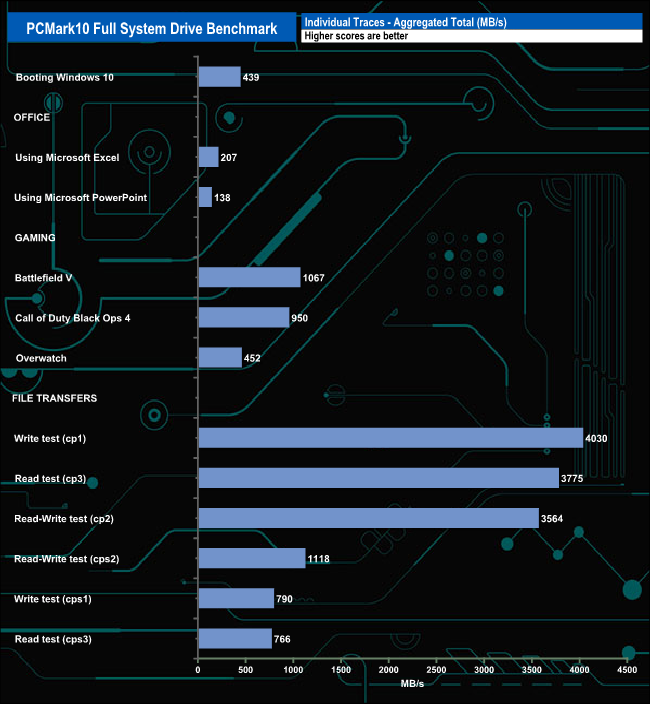
When it came to the three gaming test traces the drive averaged 823MB/s with the fastest being Battlefield V at 1,067MB/s and the slowest, Overwatch at 452MB/s. Call Of Duty Black Ops 4 was in the middle of these two at 950MB/s. Switching over to the file transfer tests the drive averaged 2,348.83MB/s for the six tests, the fastest of which was the cp1 Write test at 4,030MB/s.
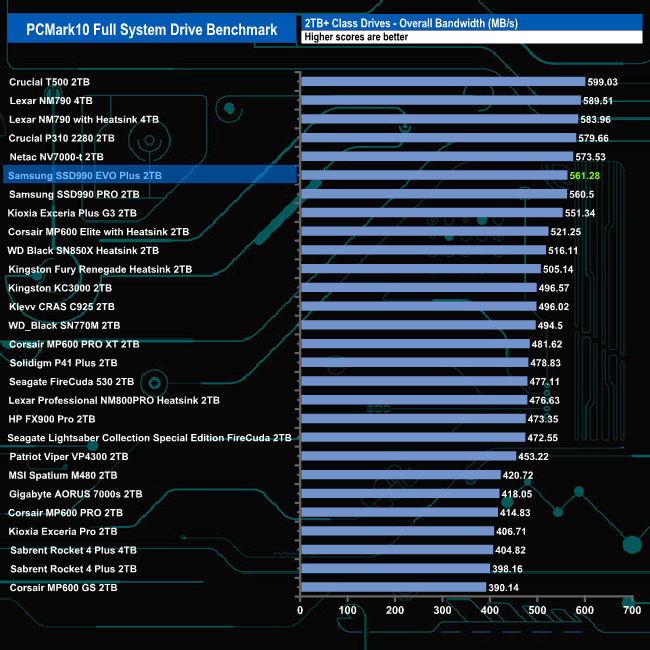
The SSD990 EVO Plus slips into sixth place in the overall bandwidth chart, just a head of the SSD990 PRO.
The 3DMark Storage Benchmark uses traces recorded from popular games and gaming-related activities to measure real-world gaming performance.
Traces used –
Battlefield V
Loading Battlefield™ V from launch to the main menu.
Call of Duty Black Ops 4
Loading Call of Duty®: Black Ops 4 from launch to the main menu.
Overwatch
Loading Overwatch® from launch to the main menu.
Game Move
Copying the Steam folder for Counter-Strike®: Global Offensive from an external SSD to the system drive.
Game Recording
Recording a 1080p gameplay video at 60 FPS with OBS (Open Broadcaster Software) while playing Overwatch®.
Installing Game
Installing The Outer Worlds® from the Epic Games Launcher.
Game Saving
Saving progress in The Outer Worlds game.
Battlefield V

The SSD990 EVO Plus did well in the Battlefield V test. Its test result of 1,175MB/s was 80MB/s faster than that of the PRO version of the SSD990.
Call of Duty Black Ops 4

The drive slipped into seventh place on the results chart for the Call Of Duty: Black Ops 4 test with a test result figure of 933.51MB/s, 237.4 MB/s faster than the SSD990 PRO.
Overwatch

In the Overwatch game loading test, the SSD990 EVO Plus test result of 480MB/s sees it just inside the top ten of drives we have tested to date with this test.
Game Move

In the game moving test the SSD990 EVO Plus is 260MB/s slower than the older SSD990 PRO.
Game Recording

In the Game Recording test, the SSD990 EVO Plus finished a few places higher in the results table than the older SSD990 PRO drive.
Installing Game

The Game Installation test is one of the few in the 3DMark Storage test where the Samsung SSD990 EVO Plus is beaten by the older Samsung SSD990 PRO.
Game Saving

In the Game Move test, there isn't much to choose between the two Samsung SSD990 drives.
Overall Access Time
Overall Bandwidth

Samsung's 2TB SSD990 EVO Plus does well overall in the 3DMark Storage Benchmark with an average bandwidth figure of 628.74MB/s, which is good enough for sixth place in the results chart.
The Final Fantasy XIV Endwalker Official Benchmark uses actual maps and playable characters to assign a score to your PC and rate its performance including scene loading times.
The benchmark gives an overall load time as well as loading times by scene.
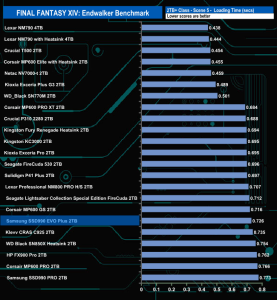
The drive shows pretty decent consistency during the Final Fantasy XIV Endwalker benchmark, ending up in a mid-table position overall.
We took note of the drive’s temperature during some of our benchmarking runs.
The SSD990 EVO Plus doesn't come with a heatsink as such but instead relies on a combination of a heat spreader label on the back of the drive, nickel plating on the controller and Samsung's Dynamic Thermal Guard technology to keep the drive working at an optimal temperature.
This system does work pretty well as the hottest the drive got when being pushed hard during our benchmarking was 49° C (during runs of ATTO) which is 21° C off of the stated maximum operating temperature of 70°C. For the bulk of our testing, the temperature averaged around 42° C, well below that maximum temperature while the 4K-based tests averaged 38.5° C.
To test real life performance of a drive we use a mix of folder/file types and by using the FastCopy utility (which gives a time as well as MB/s result) we record the performance of drive reading from & writing to a 256GB Samsung SSD850 PRO.
To get a measure of how much faster PCIe NVMe drives are than standard SATA SSD's we use the same files but transfer to and from a 2TB Kioxia Exceria Plus drive.
Transfer Details
100GB data file.
60GB iso image.
60GB Steam folder – 29,521 files.
50GB File folder – 28,523 files.
12GB Movie folder – (15 files – 8 @ .MKV, 4 @ .MOV, 3 @ MP4).
10GB Photo folder – (304 files – 171 @ .RAW, 105 @ JPG, 21 @ .CR2, 5 @ .DNG).
10GB Audio folder – (1,483 files – 1479 @ MP3, 4 @ .FLAC files).
5GB (1.5bn pixel) photo.
BluRay Movie – 42GB.
21GB 8K Movie demos – (11 demos)
16GB 4K Raw Movie Clips – (9 MP4V files).
4.25GB 3D Printer File Folder – (166 files – 105 @ .STL, 38 @ .FBX, 11 @ .blend, 5 @ .lwo, 4 @ .OBJ, 3@ .3ds).
1.5GB AutoCAD File Folder (80 files – 60 @ .DWG and 20 @.DXF).
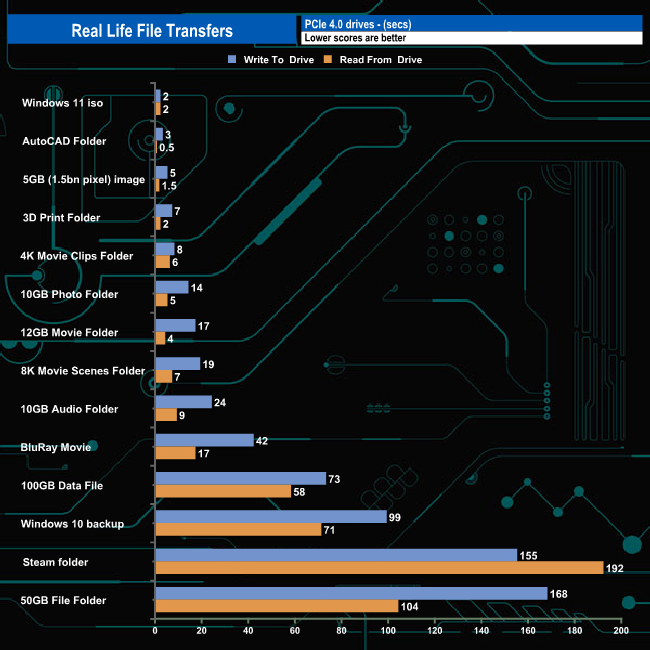
In our real-life file transfer tests the 2TB SSD990 EVO Plus averaged 1,105MB/s (average time of 44 seconds) writing the 14 transfer tests with the fastest being the 2,387MB/s Win 11 iso transfer. Reading the data back it averaged 2,220MB/s, this time the 3D Print file folder was the fastest at 3,008MB/s.
Most of our testing with the SSD990 EVO PRO was done at Gen4 x4 but we did install it in our Gen 5 test rig to run a few tests to see what the Gen5 x2 option brings in terms of performance.
The biggest difference we saw came from using the random QD32 T16 test in the Peak Performance profile in CrystalDiskMark 8. With the Gen 4 interface, we couldn't get close to the official maximums of 1,000,000 IOPS and 1,350,000 IOPS for reads and writes, respectively with test scores of 778,923 IOPS for reads and 577,895 IOPS for writes. With the Gen 5 x2 interface, we could confirm the official read rating with a test result of 1,021,378 IOPS, but we were still short when it came to the write performance, at 1,271,162 IOPS.
The SSD990 EVO Plus is the latest SSD to arrive from Samsung. The new drive uses a DRAM-less design controller and Samsung's latest 8th generation 236-layer 3-bit MLC (TLC) V-NAND and it can run at either PCIe Gen 4 x4 or PCIe Gen 5 x2.
Details about the new Piccolo controller are thin on the ground but the 4-channel DRAM-less controller is built on a 5nm process. Although it uses the same controller as the previous SSD990 EVO drive, the more advanced 8th gen NAND and firmware optimisations in the latest drive, see improvements in both power consumption and efficiency (MB/s per Watt). Samsung claims improvements of up to 16% and 11% for read and writes respectively for power consumption while power efficiency sees up to 73% improvement in reads and up to 48% for writes.
At launch, the drive comes in three capacities, 1TB, 2TB (the drive we are reviewing) and a flagship 4TB model. At the time of writing the 990 EVO Plus comes as a ‘plain' drive (there are no heatsink-equipped versions) and to keep the drive cool in operation it uses a combination of a copper heat spreader built into the label, a nickel coating on the controller and Samsung’s DTG (Dynamic Thermal Guard) algorithm.
The drive features Samsung's Intelligent TurboWrite 2.0 technology to improve write performance. The dynamic TurboWrite region of the 2TB drive supports up to 216GB (double that of the 2TB SSD990 EVO). The 1TB drive supports up to 108GB, and the 4TB model supports 432 GB.
Samsung rates the Sequential performance of the 2TB drive as up to 7,250MB/s for reads and up to 6,300MB/s for writes. When we tested the drive with the ATTO benchmark, the best we saw from the drive was 6,750MB/s for reads and 5,610MB/s for writes. Switching over to the CrystalDiskMark 8 benchmark we could confirm the official read figure with a test result of 7,281MB/s. However, the write result was still short of the official rating at 6,077MB/s.
When it came to 4K random performance, we couldn't get anywhere close to the official figures under testing. Samsung quotes read/write figures for the 2TB drive of up to 1,000,000 IOPS and 1,350,000 IOPS respectively. With our standard 4-threaded tests the best we saw from the drive was 373,769 IOPS for reads and 294,019 IOPS for writes. The best performance figures we saw from the drive came from using the Peak Performance profile in Crystal Disk Mark 8 with reads (default) at 778,923 IOPS and writes (compressed data) at 593.118 IOPS.
We found the Samsung 990 EVO Plus 2TB on Scan at a special offer price of £159.98 (inc VAT) instead of £179.99 HERE
Pros
- Overall performance.
- TCG Opal 2.0 encryption.
- Magician software.
- 5-year warranty.
Cons
- Tested 4K performance couldn’t match the official maximum figures.
Kitguru says: Samsung's SSD990 EVO Plus may have the same controller as the previous EVO drive but thanks to the more modern version 8 NAND it uses and tweaks to the firmware it's a much more power-efficient drive than its predecessor. The Gen5 x2 support and lowish power demands make it an interesting option for mobile devices, but the market segment the drive is entering is highly competitive, to say the least.
 KitGuru KitGuru.net – Tech News | Hardware News | Hardware Reviews | IOS | Mobile | Gaming | Graphics Cards
KitGuru KitGuru.net – Tech News | Hardware News | Hardware Reviews | IOS | Mobile | Gaming | Graphics Cards


